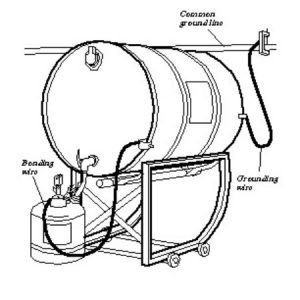 Static electricity can become a huge threat in the workplace, especially when working on or around fueling operations. If there is a discharge of static electricity while fuel is being dispensed, there is a possibility of an explosion or fire erupting. In simple terms, static electricity is an imbalance of negatively and positively charged particles. In order to reduce this hazard at your workplace, remember the terms ‘bonding’ and ‘grounding.’ These denote a safeguard that will prevent the potential for static discharge to occur during fuel transferring activity.
Static electricity can become a huge threat in the workplace, especially when working on or around fueling operations. If there is a discharge of static electricity while fuel is being dispensed, there is a possibility of an explosion or fire erupting. In simple terms, static electricity is an imbalance of negatively and positively charged particles. In order to reduce this hazard at your workplace, remember the terms ‘bonding’ and ‘grounding.’ These denote a safeguard that will prevent the potential for static discharge to occur during fuel transferring activity.
Static Electricity and Grounding:
The movement of volatile materials through hoses and piping can create electrostatic charge. When the voltage associated with that charge reaches certain levels, a spark can jump across the gap between a dispensing nozzle and a portable container and ignite flammable vapors. Static charges, however, will not accumulate if equipment is firmly electrically grounded. Grounding “bleeds off” the charges, directing them harmlessly to the earth. Proper grounding dissipates the charges as fast as they are generated. Bond a conductive wire from the metal 55-gallon drum to the metal 5-gallon container. Be sure the two contact surfaces are not painted. It’s always a good idea to have a safety professional, electrical engineer, and your plant maintenance person test the bonding and grounding.
FIRE DESTRUCTION IS ONE MAN’S JOB…FIRE PREVENTION IS EVERYBODY’S JOB!!
Download flyer: STOTW_909_FuelTransferStatic ElectricitySafety Download Spanish flyer: STOTW_909_FuelTransferStatic ElectricitySafety_esp

